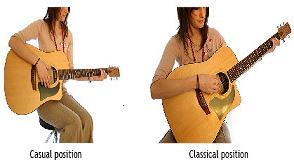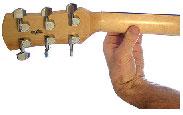Learn to Play The Guitar mini-course Lesson 1

Part One--Introduction to the Lead Guitar and
How to read TAB
Getting into Position. Information that every beginner
should know before they start out!
Using a pick . One of the most important things you must
know if you want to progress with your playing.
Introduction to TAB. The basis a lot of guitar music
notation.
Getting into Position
Sitting Positions
There are two sitting positions for holding the guitar; classical
and casual. Even though it's an acoustic pictured below the
same principles apply for electric.
1. Pick up the guitar and make sure that the guitar body is
supported by your leg.
2. Position yourself at the edge of your chair.
3. Ensure that your back is relaxed but straight.
4. Lean the guitar back towards you slightly.

Standing Position
1. Pick up the guitar and place the strap over your shoulder.
Adjust the strap so that the guitar is positioned mid-body.
2. Use your left hand to support the neck of the guitar.
3. Rest your right hand over the bridge of the guitar.

Hand Positions
It is important that you relax your wrists and hands. Straining
them can cause injury.
Front View-- Rear View


Warning! Make sure that you never position your hand like this:

Your thumb should never be placed this low on the neck of the
guitar as
it puts unneccessary strain on your wrist and thumb.
Fretting
When you play the guitar, you use your left hand fingers to press down the strings
on the fret board of the guitar and use your right hand to pluck or strum the stings at
the bridge end of the guitar. Using your left hand to press the strings on the fret board
is called fretting. Here are some tips you will need to know:
1. Short fingernails are essential. 2. Use only the tips of your fingers to press the
strings. 3. When making a chord, be sure that each fingertip is placed within
the frets. We will cover chords in lesson one. 4. Check each string that it rings
clearly and is not muted or buzzing.
As a beginner guitarist, it may hurt your fingers to play. This is normal.
Every guitarist starts this way for the first couple of weeks. With practice,
you will develop guitar fingers (hard skin on your fingertips).
Holding the Pick
Position the pick between thumb and index fingers like in the diagram
below:

Time to take a break. Well done, you've just completed the first part of
this newsletter. Next we're going to have a look at the guitar neck and
what the parts are.
Don't forget, for the Jamorama Lead Guitar Learning Kit which includes
step-by-step written lessons, video lessons, audio lessons and sophisticated
software games,
visit Jamoramalead.com
Now you are ready to start your first lesson. We are going to look at the
guitar neck and then how to read guitar TAB.
Remember! It is more beneficial for you to practice several times
during a week than to practice for one long session. This is because
your brain processes information in chunks at a time and it can only
hold a certain amount in short term storage.
For example, with phone numbers, it is very difficult to remember
any more than 7 digits at a time. Yet if you give yourself time
between practicing, even if it is just 10 minutes, you’ll find that
your brain is much more efficient at turning your short term
practice into long term knowledge. More information on
effective learning is contained in Jamorama at Jamoramalead.com.
Ok. That aside, let’s get started on the lesson. To start with,
I want you to have a look at the guitar neck diagram below
and make note of all the relevant pieces of information. 
Frets The guitar neck is divided
into what we call frets, making
a fret board. Most guitars have
around 20 frets. In these first
lessons, we will focus on the first
four, also known as the first
position. Notice that we
number each fret starting
at 1 at the head of the guitar
Note: Each string on the guitar is numbered. When you hold
your guitar as you would when using the casual playing position,
the 1st string is at the bottom and the 6th string is at the top.
Notice also the term, ‘Tuning’ at the bottom of the above
diagram. Tuning refers to the notes that the guitar strings
are tuned to. In the above diagram, I have given a very
common tuning called standard E tuning that consists
of the notes E, A, D, G and B. Strings 1 and 6 are both tuned
to the note E. The open 6th string is called low E. The open
1st string is called high E as it is two octaves higher than the
6th string open E. I will explain notes and octaves to you in a
later newsletter, but for now, you only need to know the names
of the notes in standard open E tuning.
standard E tuning (the most common tuning). If you don't know how to tune your guitar, then download my free guide to tuning your guitar from:
http://www.jamorama.com/tuning/tuning.pdf. Or if you are already a member of Jamoramalead.com, youcan use our guitar tuning software to help you tune yourguitar.**Note: To open the above tuning.pdf file you'll need a
copyof Adobe Acrobat Reader. You can download a free copy ofthis from:
http://www.adobe.com/products/acrobat/readstep2.htmlWe will stick to standard E tuning throughout this newsletter, but you can find other tunings to play with in our member’s area at
JamoramaLead.com.
Guitar Lesson - How to Read Guitar Tablature TAB or tablature is the most
common method of writing
out music for the guitar. It is different from classical music
notation in that; TAB uses ordinary numbers and keyboard
characters as opposed to standard musical notation which
uses symbols. Because of this format, anyone with a computer can
write or read TAB making it the most user friendly way
to read and communicate guitar music. Also TAB relates
directly to the fret board of your guitar meaning that you
may easily see where you put your fingers.
In the full version of Jamoramalead, both standard musical
notation and tablature are used. But for this six day course we
will only use TAB. The reason for this is that tablature is very
easy to read and you should have no problems learning TAB
in a few short minutes of reading.
TAB has some weak points, the worst of which is that rhythm
can't be easily indicated. This shouldn't pose a problem though,
as I will indicate the rhythm for each exercise using the strum
indicators that were introduced in lesson one.
OK. To start I want you to look at your guitar and you will clearly
see that it has six strings going from thickest to thinniest. On a
TAB diagram, the thinnest string, (or 1st string as its most
commonly called) is at the top - The thickest (or 6th string)
is at the bottom. This is clearly demonstrated in the 1st
example below.
The following diagram shows you how tablature relates to the
guitar fret board:

Some of you may notice that this guitar seems upside down in relation
to how you play. This is simply the way that guitar music is
generally written. Now if you transfer this same model to a
written format you will get TAB, which can be seen below.

So the lines above indicate the strings on a guitar. The top line
of the TAB being the thinnest string of the guitar, and the
bottom line on the TAB chart indicating the thickest string
of the guitar. Now if you look at your guitar you will see
metal bars that raise up from the neck of the guitar called
frets. TAB uses numbers to show you which one of these frets
For example, look at the tab diagram below and you can see that the 1st string (thinnest string) is being played. The number refers to the fret that you should press down. In this case the number zero is displayed. This means that you shouldn’t press down anything.
to press down and play.

So if you were to play the above piece of TAB on your guitar,
you would pick the thinnest string once with your plucking
hand and do nothing with your fret hand.
Tip: If you are having trouble with this concept, you can
download a video example of the above exercise to see and
hear it for yourself. The download links are below (right
click on the link and select "save as"):
Video Available:
QuickTime - Exercise 1 (1.35 MB)
Now let's see if we can start pushing down some strings.
Look at the next example below and try and play the note
that the TAB chart displays.

If you pressed down the thickest string at
the 3rd fret then
you played the exercise correctly.
If you are still unsure
whether you are doing the right thing or not, refer to the
video below.
Tip: The download links are below (right click on the link
and select "save as"):
Video Available:
QuickTime - Exercise 2 (1.04 MB)
Let's try another one. Play the following piece of TAB:

This TAB diagram above indicates the 2nd string
(second thinnest) and you should be pressing down
on the first fret.
Tip: Once again, there is video available for this example.
The download links are below (right click on the link
and select "save as"):
QuickTime - Exercise 3 (1.11 MB) This was your first lesson of this mini-course there are
six lessons so stay tuned or go to http://www.jamorama.com
to start your full course.
Comments